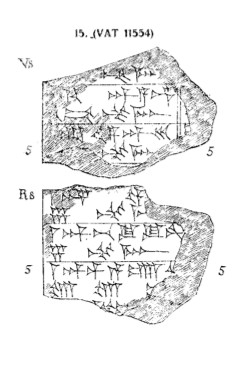A Fragment of an Assyrian King List (VAT 11554)
This small fragment of the Assyrian King List from Aššur (KAV 15) was the first copy of that important chronographic text to be published; O. Schroeder's hand-drawn facsimile appeared in 1920, seven years before the better preserved Nassouhi List appeared in print. Its damaged contents can now be fully restored from the two best preserved versions of the AKL: the Khorsabad List and the SDAS List.
The fragment is not preserved enough to be able to date it with any certainty, although there is general agreement among scholars for an early dating. For example, A. Poebel (1942:251) proposes that VAT 11554 is the earliest extant version of the AKL, suggesting that it might end "six or seven more reigns before" Tiglath-pileser II (966-935). This interpretation has been accepted by, among others, B. Landsberger (JCS [1954] 39 n. 48) and A.K. Grayson (AOAT 1:109). J.A. Brinkman (1973:314), however, has argued that an estimate based on the shape of the fragment would, in fact, result in a much later dating around the same time as the Nassouhi List.

Schroeder, KAV 15.
Five lines and seven lines are preserved on the obverse and reverse respectively. These lines record information on the reigns of Sargon I (no. 35), Puzur-Aššur I (no. 36), Narām-Sîn (no. 37), Aššur-nārārī III (no. 80), Enlil-kudurrī-uṣur (no. 81), and Ninurta-apil-Ekur (no. 82). Like the other versions of the AKL, the number of regnal years for the three Old Assyrian rulers (nos. 35-37) have not survived in the VAT 11554 list.
| Line | Ruler No. | Translation | Translation |
| Obv. 0ʹ | (35) | [Sargon [/riao/ria1/earlybeginnings/puzurashurdynasty/sargoni/index.html] (I), | [son of Ikūnum [/riao/ria1/earlybeginnings/puzurashurdynasty/ikunum/index.html]], | ||||
| 1ʹ | [x] years. | [he ruled] |
| 2ʹ | (36) | [P]uzur-Aššur (II), | [son of Sarg]on [/riao/ria1/earlybeginnings/puzurashurdynasty/sargoni/index.html] (I)], | |||||
| 3ʹ | [bro]ken years | [he ruled] |
| 4ʹ | (37) | Narām-Sîn, | [son of Puzur-Aššur (II)], | |||||
| 5ʹ | [x] years | [he ruled] |
| Rev. 1ʹ | (80) | Aššur-nār[ārī (III), | [son of Aššur-nādin-apli [/riao/ria2/ashurnadinapli/index.html]], | |||||
| 2ʹ | [x] years | [he ruled] |
| 3ʹ | (81) | Enlil-kudurrī-uṣur, | [son of Tukultī-Ninurta [/riao/ria2/tukultininurtai/index.html] (I)], | |||||
| 4ʹ | 5 years | [he ruled] |
| 5ʹ | (82) | Ninurta-apil-E[kur] [/riao/ria2/ninurtaapilekur/index.html], | [son of Ilu-iḫadda], | |||||
| 6ʹ | to Karduniaš, descendant of [Erība-Adad [/riao/ria1/oldassyrianperiod/mittanianhegemony/eribaadadi/index.html] (I)], | [he went ] | ||||||
| 7ʹ | [to] K[arduniaš] | [from Karduniaš he went up] |
Footnotes
| 0ʹ | Here, the first line is marked "0" in order to add the suggested line without interferring with Schroeder's numbering (see figure). |
Selected Bibliography
Nathan Morello
Nathan Morello, 'A Fragment of an Assyrian King List (VAT 11554)', The Royal Inscriptions of Assyria online (RIAo) Project, The RIAo Project, a sub-project of MOCCI, 2023 [http://oracc.museum.upenn.edu/riao/kinglists/assyriankinglist/fragmentvat11554/]